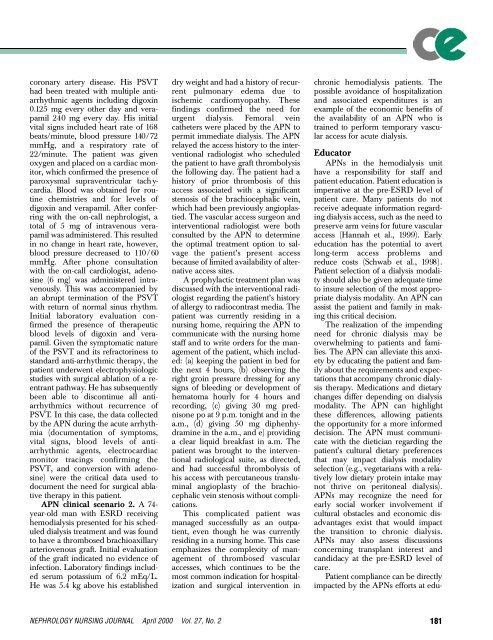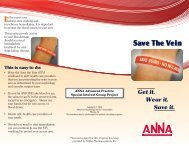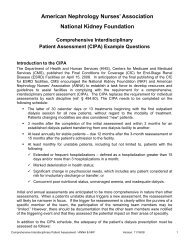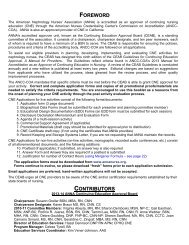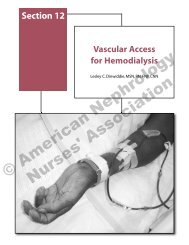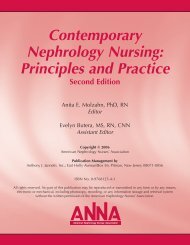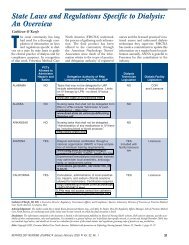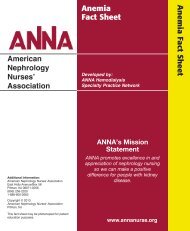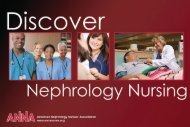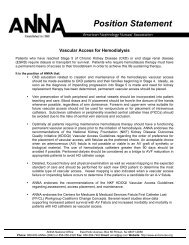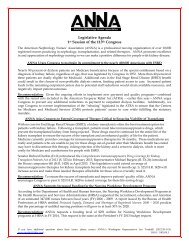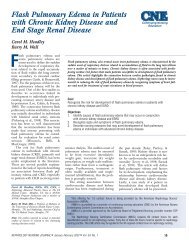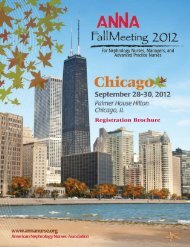Advanced Practice Nurses: Roles in the Hemodialysis Unit
Advanced Practice Nurses: Roles in the Hemodialysis Unit
Advanced Practice Nurses: Roles in the Hemodialysis Unit
Create successful ePaper yourself
Turn your PDF publications into a flip-book with our unique Google optimized e-Paper software.
coronary artery disease. His PS V T<br />
had been treated with multiple antiarrhythmic<br />
agents <strong>in</strong>clud<strong>in</strong>g digox<strong>in</strong><br />
0 .125 mg every o<strong>the</strong>r day and verapamil<br />
240 mg every day. His <strong>in</strong>itial<br />
vital signs <strong>in</strong>cluded heart rate of 168<br />
beats/m<strong>in</strong>ute, blood pressure 140 / 72<br />
mmHg, and a respiratory rate of<br />
22/m<strong>in</strong>ute. The patient was given<br />
oxygen and placed on a cardiac monitor,<br />
which confirmed <strong>the</strong> presence of<br />
paroxysmal supraventricular tach ycardia.<br />
Blood was obta<strong>in</strong>ed for rout<strong>in</strong>e<br />
chemistries and for levels of<br />
digox<strong>in</strong> and verapamil. After conferr<strong>in</strong>g<br />
with <strong>the</strong> on-call nephrologist, a<br />
total of 5 mg of <strong>in</strong>travenous verapamil<br />
was adm<strong>in</strong>istered. This resulted<br />
<strong>in</strong> no change <strong>in</strong> heart rate, however,<br />
blood pressure decreased to 110 / 60<br />
mmHg. After phone consultation<br />
with <strong>the</strong> on-call cardiologist, adenos<strong>in</strong>e<br />
(6 mg) was adm<strong>in</strong>istered <strong>in</strong>trav<br />
e n o u s l y. This was accompanied by<br />
an abrupt term<strong>in</strong>ation of <strong>the</strong> PS V T<br />
with return of normal s<strong>in</strong>us rhythm.<br />
Initial laboratory evaluation confirmed<br />
<strong>the</strong> presence of <strong>the</strong>rapeutic<br />
blood levels of digox<strong>in</strong> and verapamil.<br />
Given <strong>the</strong> symptomatic nature<br />
of <strong>the</strong> PSVT and its refractor<strong>in</strong>ess to<br />
standard anti-arrhythmic <strong>the</strong>rapy, <strong>the</strong><br />
patient underwent electrophysiologic<br />
studies with surgical ablation of a reentrant<br />
pathway. He has subsequently<br />
been able to discont<strong>in</strong>ue all antiarrhythmics<br />
without recurrence of<br />
PS V T. In this case, <strong>the</strong> data collected<br />
by <strong>the</strong> APN dur<strong>in</strong>g <strong>the</strong> acute arrhythmia<br />
(documentation of symptoms,<br />
vital signs, blood levels of antiarrhythmic<br />
agents, electrocardiac<br />
monitor trac<strong>in</strong>gs confirm<strong>in</strong>g <strong>the</strong><br />
PSVT, and conversion with adenos<strong>in</strong>e)<br />
were <strong>the</strong> critical data used to<br />
document <strong>the</strong> need for surgical ablative<br />
<strong>the</strong>rapy <strong>in</strong> this patient.<br />
A PN cl<strong>in</strong>ical scenario 2. A 74 -<br />
year-old man with ESRD receiv<strong>in</strong>g<br />
hemodialysis presented for his sch e duled<br />
dialysis treatment and was found<br />
to have a thrombosed brach i o a x i l l a r y<br />
arteriovenous graft. Initial evaluation<br />
of <strong>the</strong> graft <strong>in</strong>dicated no evidence of<br />
<strong>in</strong>fection. Laboratory f<strong>in</strong>d<strong>in</strong>gs <strong>in</strong>cluded<br />
serum potassium of 6.2 mEq/L .<br />
He was 5.4 kg above his established<br />
dry weight and had a history of recurrent<br />
pulmonary edema due to<br />
i s chemic cardiomyopathy. These<br />
f<strong>in</strong>d<strong>in</strong>gs confirmed <strong>the</strong> need for<br />
urgent dialysis. Femoral ve<strong>in</strong><br />
ca<strong>the</strong>ters were placed by <strong>the</strong> APN to<br />
permit immediate dialysis. The APN<br />
relayed <strong>the</strong> access history to <strong>the</strong> <strong>in</strong>terventional<br />
radiologist who sch e d u l e d<br />
<strong>the</strong> patient to have graft thrombolysis<br />
<strong>the</strong> follow<strong>in</strong>g day. The patient had a<br />
history of prior thrombosis of this<br />
access associated with a significant<br />
stenosis of <strong>the</strong> brachiocephalic ve<strong>in</strong>,<br />
w h i ch had been previously angioplastied.<br />
The vascular access surgeon and<br />
<strong>in</strong>terventional radiologist were both<br />
consulted by <strong>the</strong> APN to determ<strong>in</strong>e<br />
<strong>the</strong> optimal treatment option to salvage<br />
<strong>the</strong> patient’s present access<br />
because of limited availability of alternative<br />
access sites.<br />
A prophylactic treatment plan was<br />
discussed with <strong>the</strong> <strong>in</strong>terventional radiologist<br />
regard<strong>in</strong>g <strong>the</strong> patient’s history<br />
of allergy to radiocontrast media. The<br />
patient was currently resid<strong>in</strong>g <strong>in</strong> a<br />
nurs<strong>in</strong>g home, requir<strong>in</strong>g <strong>the</strong> APN to<br />
communicate with <strong>the</strong> nurs<strong>in</strong>g home<br />
staff and to write orders for <strong>the</strong> management<br />
of <strong>the</strong> patient, which <strong>in</strong>cluded:<br />
(a) keep<strong>in</strong>g <strong>the</strong> patient <strong>in</strong> bed for<br />
<strong>the</strong> next 4 hours, (b) observ<strong>in</strong>g <strong>the</strong><br />
right gro<strong>in</strong> pressure dress<strong>in</strong>g for any<br />
signs of bleed<strong>in</strong>g or development of<br />
hematoma hourly for 4 hours and<br />
record<strong>in</strong>g, (c) giv<strong>in</strong>g 30 mg prednisone<br />
po at 9 p.m. tonight and <strong>in</strong> <strong>the</strong><br />
a.m., (d) giv<strong>in</strong>g 50 mg diphenhydram<strong>in</strong>e<br />
<strong>in</strong> <strong>the</strong> a.m., and e) provid<strong>in</strong>g<br />
a clear liquid breakfast <strong>in</strong> a.m. The<br />
patient was brought to <strong>the</strong> <strong>in</strong>terventional<br />
radiological suite, as directed,<br />
and had successful thrombolysis of<br />
his access with percutaneous translum<strong>in</strong>al<br />
angioplasty of <strong>the</strong> brach i ocephalic<br />
ve<strong>in</strong> stenosis without complic<br />
a t i o n s .<br />
This complicated patient was<br />
managed successfully as an outpatient,<br />
even though he was currently<br />
resid<strong>in</strong>g <strong>in</strong> a nurs<strong>in</strong>g home. This case<br />
emphasizes <strong>the</strong> complexity of management<br />
of thrombosed vascular<br />
accesses, which cont<strong>in</strong>ues to be <strong>the</strong><br />
most common <strong>in</strong>dication for hospitalization<br />
and surgical <strong>in</strong>tervention <strong>in</strong><br />
chronic hemodialysis patients. The<br />
possible avoidance of hospitalization<br />
and associated expenditures is an<br />
example of <strong>the</strong> economic benefits of<br />
<strong>the</strong> availability of an APN who is<br />
tra<strong>in</strong>ed to perform temporary vascular<br />
access for acute dialysis.<br />
E d u c a t o r<br />
A PNs <strong>in</strong> <strong>the</strong> hemodialysis unit<br />
have a responsibility for staff and<br />
patient education. Patient education is<br />
imperative at <strong>the</strong> pre-ESRD level of<br />
patient care. Many patients do not<br />
receive adequate <strong>in</strong>formation regard<strong>in</strong>g<br />
dialysis access, such as <strong>the</strong> need to<br />
preserve arm ve<strong>in</strong>s for future vascular<br />
access (Hannah et al., 1999). Early<br />
education has <strong>the</strong> potential to avert<br />
long-term access problems and<br />
reduce costs (Schwab et al., 1998 ) .<br />
Patient selection of a dialysis modality<br />
should also be given adequate time<br />
to <strong>in</strong>sure selection of <strong>the</strong> most appropriate<br />
dialysis modality. An APN can<br />
assist <strong>the</strong> patient and family <strong>in</strong> mak<strong>in</strong>g<br />
this critical decision.<br />
The realization of <strong>the</strong> impend<strong>in</strong>g<br />
need for chronic dialysis may be<br />
overwhelm<strong>in</strong>g to patients and families.<br />
The APN can alleviate this anxiety<br />
by educat<strong>in</strong>g <strong>the</strong> patient and family<br />
about <strong>the</strong> requirements and expectations<br />
that accompany chronic dialysis<br />
<strong>the</strong>rapy. Medications and dietary<br />
changes differ depend<strong>in</strong>g on dialysis<br />
m o d a l i t y. The APN can highlight<br />
<strong>the</strong>se differences, allow<strong>in</strong>g patients<br />
<strong>the</strong> opportunity for a more <strong>in</strong>formed<br />
decision. The APN must communicate<br />
with <strong>the</strong> dietician regard<strong>in</strong>g <strong>the</strong><br />
patient’s cultural dietary preferences<br />
that may impact dialysis modality<br />
selection (e.g., vegetarians with a relatively<br />
low dietary prote<strong>in</strong> <strong>in</strong>take may<br />
not thrive on peritoneal dialysis).<br />
A PNs may recognize <strong>the</strong> need for<br />
early social worker <strong>in</strong>volvement if<br />
cultural obstacles and economic disadvantages<br />
exist that would impact<br />
<strong>the</strong> transition to chronic dialysis.<br />
A PNs may also assess discussions<br />
concern<strong>in</strong>g transplant <strong>in</strong>terest and<br />
candidacy at <strong>the</strong> pre-ESRD level of<br />
c a r e .<br />
Patient compliance can be directly<br />
impacted by <strong>the</strong> APNs efforts at edu-<br />
NEPHROLOGY NURSING JOURNAL April 2000 Vol. 27, No. 2 181


